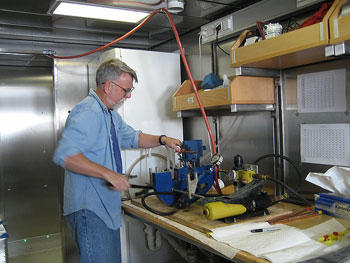Day 10 - 4 July
Our nightly mapping and CTD series are showing increasingly interesting features.
Main content
Position: 73N 8E
Temperature: 5.9 (air) 7.0 (water)
Wind speed: 7.3m/s
Wave height: 1.7m (average)
Visibility: good
Weather: mostly overcast
Today we decided to send down the ROV for a look. It has been down for four hours now exploring the valley. Perhaps it will break two Norwegian records: greatest depth for a dive by a Norwegian ROV and longest underwater trip by a Norwegian ROV!
Although we have not yet found any hydrothermal vents, the ROV is showing images of past volcanic activity. We first arrived in a field of sharp basaltic rock. We have crossed several areas of older, more sediment-covered, rounded volcanic rock.
We also received a request to explain why we keep looking for methane. Guest researcher Eric Olson from the University of Washington explains.
Hydrothermal vent fluids contain a number of reduced materials including methane. Methane just happens to be the one that is both relatively easy and relatively quick to test for. Methane levels in normal seawater are also very low; less that 1 nanomol per litre. The highest methane anomaly we have seen in our CTD activity is in the area of 160-170 nanomols per litre.
Eric explains that while methane is an important tracer of hydrothermal activity, it takes a couple of years of detailed study of the vent system to ascertain where it comes from.
The researchers are also measuring hydrogen levels as a second indicator of hydrothermal activity. Hydrogen can only be of hydrothermal origin. We have also been getting high hydrogen levels in our samples.
